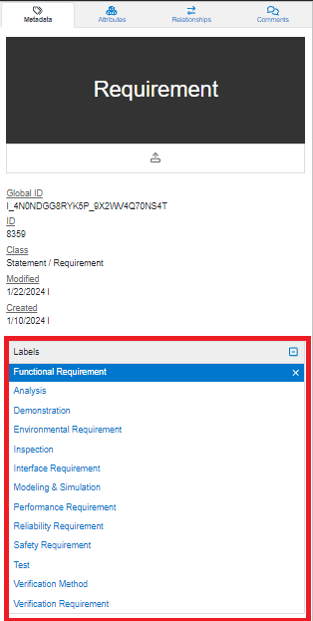Entity Data Elements
Exploring Labels, Attributes, and Relationships - The Fundamental Building Blocks of Entities in Innoslate
Entity Elements Available in this Section
| Feature | Description |
|---|---|
| Attributes | Entity attributes in Innoslate refer to specific characteristics of entities, offering a structured way to store and organize data. |
| Relationships | Entity relationships in Innoslate define how different entities trace to and interact each other, allowing for an understanding and representation of your components. |
| Labels | Entity labels in Innoslate serve to categorize and identify entities, simplifying navigation and management within complex projects. |
Attributes
What is an Attribute?
A shortened definition of an attribute, as described in the Lifecycle Modeling Language (LML) Specification:
An attribute is an inherent characteristic or quality of an entity. It further describes the entity, enhancing its uniqueness.
Every attribute shall have a name to identify it uniquely within an entity. The name is a word or small collection of words providing an overview of information about the attribute. The attribute data type … specifies the data associated with the attribute. Attribute names shall be unique within an entity, but may be used in other entities, …
In terms of the English language, an attribute is like an adjective.
We applied this LML definition of an attribute to the individual pieces of information, which can be stored within an entity. An attribute is one of the basic components of an entity.
Each entity in Innoslate includes a name, number, description, possible additional attributes, and relationships with other entities. The current acceptable set of attribute data types as defined by LML Specification 1.4 is as follows:
- Text – a single character, single word, or multiple words
- Number – any individual real number
- Boolean – the two possible logical values “true” and “false”
- Percent – a special case of Number where the value is restricted to values between zero and one hundred, inclusive
- URI – a special case of Text where the value must be a Uniform Resource Identifier or web address
- DateTime – a specific method of storing a given date and time value
- Enumeration – a set of defined choices, where the selection of only one choice is permitted
- GeoPoint – a longitude and latitude pair on the surface of a body
Innoslate implements the above set of available attribute data types and extends that set with the data types listed below:
- Big Text – any multiple lines of text
- Equation – LaTeX-based formula editor
- File – an uploaded file
- Duration – a specific method of storing a length of the time value
- Quality – any boolean parameter used to identify better requirements
- Multiplicity – a number or number range
- Computable- a feature that can compute user defined attributes (available in v4.9)
- Equation- a feature to display equations in LaTeX.
- Html- a rich text field for users to be able to utilize HyperText Markup Language.
- Multiselect- a list of predefined options for selecting multiple values.
- User Team- any user or team within the Innoslate organization.
Relationships
What is a Relationship?
A shortened definition of a relationship, as described in the Lifecycle Modeling Language (LML) Specification 1.4:
A relationship connects entities to each other. …
In LML, all relations shall be defined in both directions and shall have unique names with the same verb. … Each relationship and its inverse shall have unique names. Relationship names shall also be unique across the whole schema.
The relationships enable an English reading of the way entities connect.
We applied this LML definition of a relationship to the bi-directional connections, which can be made between two entities in Innoslate. For example, the standard parent-child relationship (used by all LML entities) is ‘decomposed by’ and its inverse is ‘decomposes.’
The relationships that are available in Innoslate mirror those defined in Table 3-3. Summary Table of LML Relationships (recreated below) of the LML Relationships Specification 1.4:

Users may also find a more simplified version of the schema, by class, here.
Labels
What is a Label?
A label is an identifying short word or phrase used to classify similar entities into categories, much like a folder system, which is used to group together like entities from the same class. Differing from project folders, however, more than one label can be applied to each entity, allowing the user to categorize, and subsequently filter, similar entities as they see fit.
Innoslate users have the ability to label entities using the ‘Metadata’ tab found in the left sidebar within most views, inside a project.

Label options vary, depending on the ‘Class’, or type, of the entity that is selected. Innoslate users may also customize new labels using the Schema Editor.
Please Note: LML does not claim to solve all of your data capture needs. That is why we have included the capability to extend the default database schema in Innoslate through the Schema Editor feature.
To continue learning about Innoslate Concepts, Click Here.
(Next Article: Innoslate Schema)
